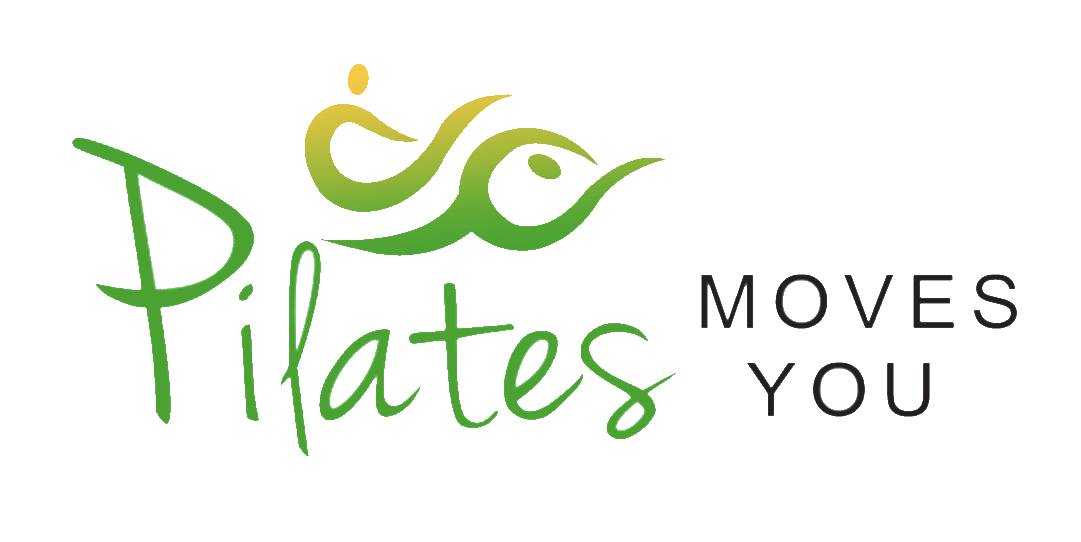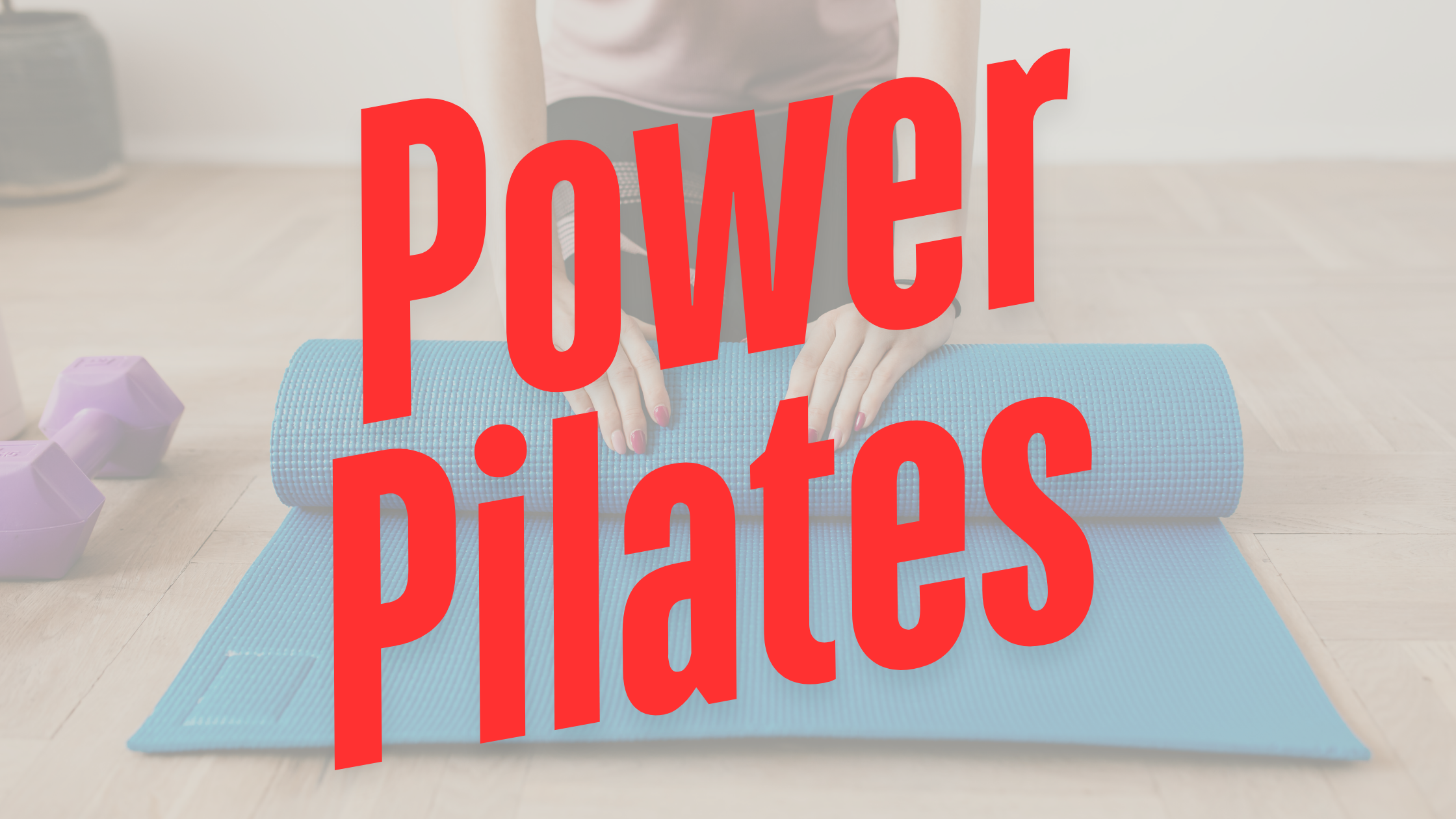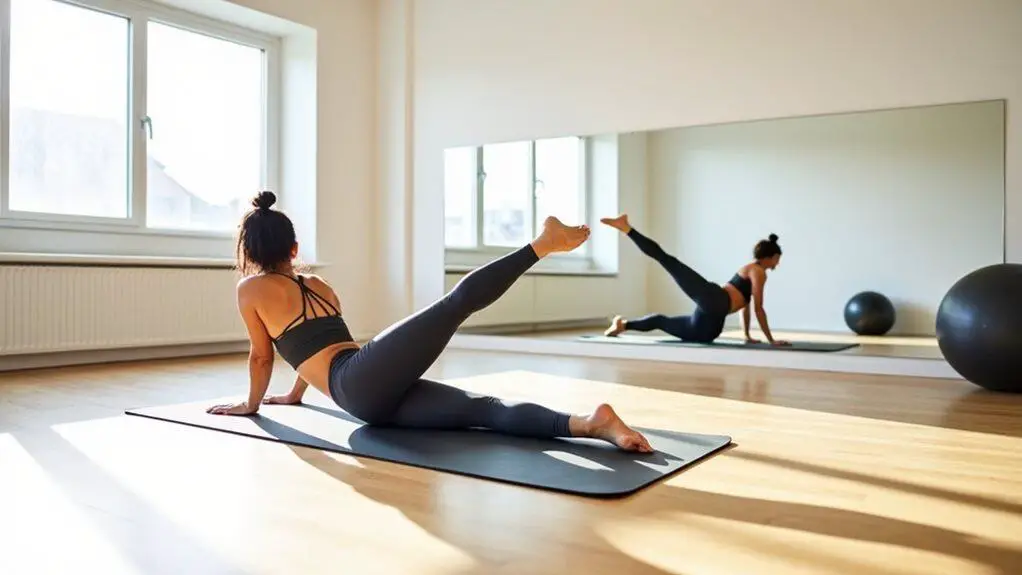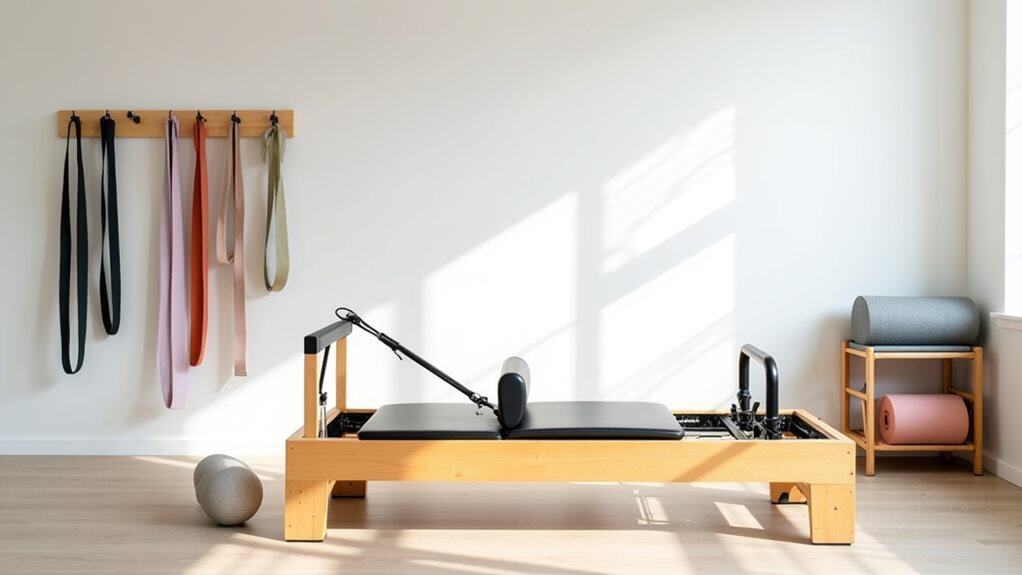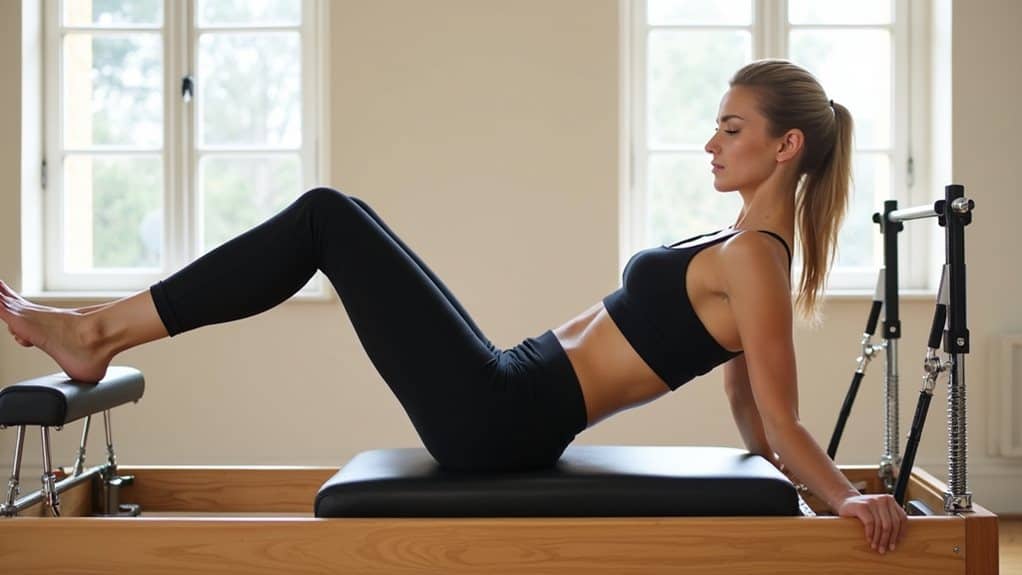Power Pilates works by combining precise, controlled movements with focused breathing to strengthen your core and enhance total body fitness. You’ll use specialized equipment like reformers and props while performing systematic exercises that build strength, flexibility, and body awareness. The method emphasizes quality over quantity, incorporating flowing sequences that target deep stabilizing muscles and improve posture. Through regular practice of these mindful movements, you’ll develop better muscle balance and motor control – but that’s just the beginning of its transformative effects.
The Core Principles of Power Pilates
The core principles of Power Pilates establish a foundation built on precision, control, and mindful movement. You’ll learn to initiate each exercise from your powerhouse, focusing on core engagement while maintaining proper form and alignment. This disciplined approach helps you develop strength and flexibility simultaneously.
Throughout your practice, you’ll combine dynamic movements with breath control, creating fluid sequences that challenge your body’s stability and endurance.
Power Pilates emphasizes quality over quantity, teaching you to execute each movement with purpose and awareness. You’ll master fundamental exercises before progressing to more advanced variations, ensuring a solid technical base.
The method’s systematic approach helps you develop better posture, increased body awareness, and improved muscle balance while preventing injury through controlled, precise movement patterns.
Equipment and Props Used in Power Pilates
Professional Power Pilates studios come equipped with specialized apparatus designed to enhance your workout experience and target specific muscle groups.
You’ll find diverse equipment that helps you maintain proper form while challenging your body through various Reformer variations and targeted exercises.
- The Reformer machine serves as the primary apparatus, featuring a sliding carriage, springs, and straps to create resistance and support movement patterns.
- Stability balls improve balance, core strength, and postural alignment during floor exercises.
- Small props like resistance bands, foam rollers, and magic circles add versatility to traditional movements.
- Wall-mounted springs and towers enable vertical plane exercises and advanced modifications.
These tools help you progress safely through different intensity levels while maintaining the precise control and fluid movement that Power Pilates demands.
You’ll learn to integrate each piece of equipment effectively to maximize your workout results.
Key Differences Between Classical and Power Pilates
Distinct philosophies and training approaches separate Classical Pilates from its Power Pilates counterpart. While Classical Pilates strictly adheres to Joseph Pilates’ original method, Power Pilates incorporates contemporary adaptations and variations.
You’ll notice key classical differences in how Power Pilates modifies traditional exercises to increase intensity and dynamic movement.
Power Pilates emphasizes a faster-paced, fitness-oriented workout that targets muscle endurance and strength building. These pilates variations include shorter holds, more repetitions, and flowing sequences that keep your heart rate elevated.
Unlike Classical Pilates’ methodical progression through specific exercise orders, Power Pilates allows for creative sequencing and modern modifications.
You’ll also find that Power Pilates integrates cardio elements and may include additional props not found in traditional practice, making it more accessible for various fitness levels.
The Science Behind Power Pilates Training
Scientific research reveals that Power Pilates effectively combines principles of muscular control, dynamic stability, and progressive resistance to create a thorough fitness approach.
When you practice Power Pilates, you’ll engage multiple muscle groups while maintaining proper breath control throughout each movement. The method relies on neuromuscular adaptation and biomechanical principles to enhance your strength and flexibility.
- Your nervous system develops enhanced motor control through repetitive, precise movements that challenge proprioception.
- Systematic muscle engagement patterns optimize the recruitment of both slow and fast-twitch muscle fibers.
- Controlled breathing techniques increase oxygen delivery to working muscles while supporting core stability.
- The progressive nature of Power Pilates training triggers adaptations in muscle tissue, leading to improved strength and endurance.
These scientific principles work together to create lasting improvements in your overall physical performance and body awareness.
Essential Power Pilates Exercises and Sequences
Core Power Pilates exercises build upon fundamental movements to create dynamic, full-body workouts that enhance strength and flexibility.
Transform your entire body with Power Pilates – where essential movements evolve into dynamic exercises that build both strength and flexibility.
You’ll start with foundational techniques like the Hundred, Roll-Up, and Single Leg Circles, focusing on precise breathing and core engagement. These Power Pilates techniques emphasize controlled, flowing movements that target multiple muscle groups simultaneously.
As you advance, you’ll incorporate more challenging sequences such as the Teaser, Snake, and Boomerang. These exercises maximize Power Pilates benefits by combining strength training with flexibility work.
You’ll progress through each movement with attention to form and alignment, maintaining a strong center while working your entire body. The sequences typically flow from mat-based exercises to standing work, creating a thorough workout that builds endurance, balance, and muscular control.
Benefits for Strength and Flexibility
Power Pilates will strengthen your core muscles through controlled movements that target your abs, back, and pelvic floor muscles.
You’ll experience increased joint mobility and range of motion as exercises systematically work through different planes of movement while maintaining proper alignment.
The method’s emphasis on precise form and controlled breathing helps develop total body stability, creating a strong foundation for everyday activities and athletic performance.
Core Muscle Development
Building strength from within, Power Pilates targets the deep muscles of your torso through controlled movements and precise breathing techniques.
You’ll develop core stability through exercises that engage multiple muscle groups simultaneously, creating a strong foundation for all physical activities. The method focuses on activating your deep abdominal muscles, lower back, and pelvic floor through systematic muscle engagement.
- Your transverse abdominis, the deepest abdominal muscle, strengthens to support proper posture
- Deep spinal muscles become more responsive, improving balance and coordination
- The pelvic floor muscles gain strength, enhancing overall core function
- Your obliques and rectus abdominis develop without creating bulk
Through consistent practice, you’ll notice improved posture, reduced back pain, and enhanced athletic performance as your core muscles become more integrated and responsive to movement demands.
Improved Joint Range
Joint mobility advances naturally as your core strength develops through Power Pilates practice. As you progress through controlled movements, you’ll notice increased flexibility in your hips, shoulders, and spine.
The systematic approach of Power Pilates emphasizes proper alignment and precise motion, which helps release tension in restricted joints.
Your flexibility training through Power Pilates isn’t limited to simple stretching. Instead, you’ll engage in dynamic exercises that combine strength and mobility work. This thorough approach helps you develop functional joint mobility that translates to everyday activities.
You’ll find improved range of motion in your ankles, knees, and elbows while maintaining stability through each movement. The controlled resistance and flowing sequences characteristic of Power Pilates create lasting improvements in your joint flexibility without compromising structural integrity.
Total Body Stability
When you develop total body stability through Power Pilates, you’ll experience a thorough improvement in both strength and flexibility. The practice emphasizes total body engagement and muscle coordination, helping you create a strong foundation for all types of movement.
Power Pilates strengthens your core while simultaneously improving your overall stability and balance.
- Your muscles learn to work together more efficiently, creating fluid movements and reducing the risk of injury.
- Deep stabilizing muscles become activated, supporting your spine and improving posture throughout daily activities.
- You’ll develop better control over your body’s movements through enhanced neuromuscular connections.
- The practice increases functional strength by targeting multiple muscle groups simultaneously while maintaining proper form.
This integrated approach to stability training guarantees you’ll build a balanced, resilient body that performs better in all activities.
Power Pilates and Cardiovascular Fitness
Power Pilates gets your heart pumping through dynamic movements and controlled resistance exercises that elevate your cardiovascular activity.
You’ll experience increased heart rate benefits as you flow through challenging sequences that combine strength training with continuous motion.
The sustained movements in Power Pilates classes help build your cardiovascular endurance while engaging multiple muscle groups, making it an effective complement to traditional cardio workouts.
Increased Heart Rate Benefits
Despite common misconceptions, Power Pilates doesn’t provide significant cardiovascular benefits or sustained elevated heart rates like traditional cardio exercises do.
While you’ll experience temporary heart rate increases during certain movements, these spikes don’t typically last long enough to create meaningful cardiovascular adaptations or sustained metabolic boost.
- Your heart rate may briefly elevate during challenging sequences, but quickly returns to baseline between exercises.
- The focus remains on controlled, precise movements rather than maintaining an elevated heart rate.
- Unlike running or cycling, Power Pilates doesn’t create the sustained cardio demand needed for heart health improvements.
- The primary benefits come from muscular endurance and flexibility gains, not cardiovascular conditioning.
To achieve heart health benefits, you’ll need to complement your Power Pilates practice with dedicated cardiovascular activities like swimming, cycling, or brisk walking.
Building Cardio Through Movement
Traditional cardio enthusiasts might be surprised to learn that Power Pilates can effectively build cardiovascular fitness through its dynamic movement patterns and flowing sequences.
You’ll experience sustained cardio benefits as you move through controlled shifts between exercises, maintaining an elevated heart rate throughout your session.
The continuous flow of movement patterns in Power Pilates challenges your cardiovascular system differently than traditional cardio exercises.
As you progress through the sequences, you’ll engage multiple muscle groups simultaneously while focusing on proper form and breathing.
This combination creates an efficient workout that improves your stamina and endurance.
You’ll notice enhanced cardiovascular capacity as your body adapts to the demands of flowing between exercises, making Power Pilates an effective method for building cardio fitness while developing strength and flexibility.
Proper Form and Breathing Techniques
When practicing Power Pilates correctly, maintaining proper form and breathing techniques serves as the foundation for maximizing your workout’s effectiveness. Proper alignment and breath control work together to create a mind-body connection that enhances your movements and prevents injury during exercises.
Mastering proper form and breath control in Power Pilates creates a vital mind-body connection that maximizes results while preventing injury.
- Keep your spine neutral and engage your core muscles throughout each movement to maintain stability.
- Focus on controlled inhales through your nose and exhales through your mouth, timing them with your exercises.
- Monitor your body’s positioning using props like mirrors or guidance from certified instructors to guarantee proper alignment.
- Practice the “Pilates breath” – drawing your navel toward your spine on exhales while maintaining ribcage stability.
Your attention to form and breathing will enhance muscle engagement, improve overall results, and help you develop better body awareness during your Power Pilates practice.
Creating an Effective Power Pilates Routine
Building upon your mastery of proper form and breathing, establishing a well-structured Power Pilates routine will help you achieve ideal results.
Start with 2-3 sessions per week, allowing adequate rest between workouts for muscle recovery and growth. Your routine should progress from basic movements to more challenging exercises as your strength improves.
Incorporate power pilates modifications that match your current fitness level while maintaining proper form.
Begin each session with a 5-minute warm-up focusing on gentle stretches and basic mat work. Structure your main workout around core-strengthening exercises, followed by upper and lower body movements.
As you advance, increase workout frequency to 4-5 sessions weekly, but listen to your body’s signals to prevent overtraining.
Remember to track your progress and adjust your routine every 4-6 weeks to prevent plateaus.
Injury Prevention and Safety Guidelines
Since Power Pilates involves precise movements and controlled resistance, proper safety measures are essential to prevent injuries and maximize benefits. By maintaining injury awareness and following established safety protocols, you’ll create a safer practice environment and protect your body during each session.
- Always warm up properly before starting your Power Pilates routine, focusing on gentle stretches and mobility exercises.
- Listen to your body’s signals and never force movements that cause pain or discomfort.
- Maintain proper form throughout each exercise, even if it means reducing repetitions or resistance.
- Work with a certified instructor initially to learn correct techniques and modifications for your fitness level.
Remember to breathe consistently throughout your practice and avoid holding your breath during challenging movements.
Proper alignment is vital – keep your spine neutral and engage your core throughout each exercise to protect your back.
Frequently Asked Questions
How Much Does a Typical Power Pilates Class Cost?
You’ll typically pay between $20-40 for a single Power Pilates class, with class duration running 45-60 minutes. Many studios offer package deals or monthly memberships that can reduce your per-class pricing considerably.
Can I Do Power Pilates While Pregnant?
While you can practice Power Pilates during pregnancy, you’ll need prenatal modifications. Consult your doctor first, and make certain your instructor’s certified in prenatal Pilates to guide you through safe exercises for each trimester.
What Should I Wear to a Power Pilates Session?
Wear fitted, stretchy clothing that allows free movement. You’ll need comfortable attire like leggings and a supportive tank top. For suitable footwear, choose grip socks or go barefoot – regular shoes aren’t necessary.
How Many Calories Does a Power Pilates Workout Burn?
You’ll burn between 175-375 calories per Power Pilates session, depending on your workout intensity. Higher-energy movements and advanced exercises increase calorie burn, while your body weight and fitness level also affect the results.
Is It Necessary to Have Prior Pilates Experience Before Starting Power Pilates?
While prior experience isn’t required, you’ll benefit from learning basic Pilates fundamentals first. Many instructors offer beginner tips and workout modifications to help you safely progress into Power Pilates’ more intense movements.
Final Thoughts
Ready to transform your fitness journey with Power Pilates? By incorporating these principles, exercises, and safety guidelines into your routine, you’ll develop remarkable core strength, flexibility, and overall body awareness. Whether you’re using specialized equipment or practicing mat-based movements, Power Pilates offers a dynamic path to enhanced physical conditioning. Remember to maintain proper form, focus on controlled breathing, and progress at your own pace for ideal results.
